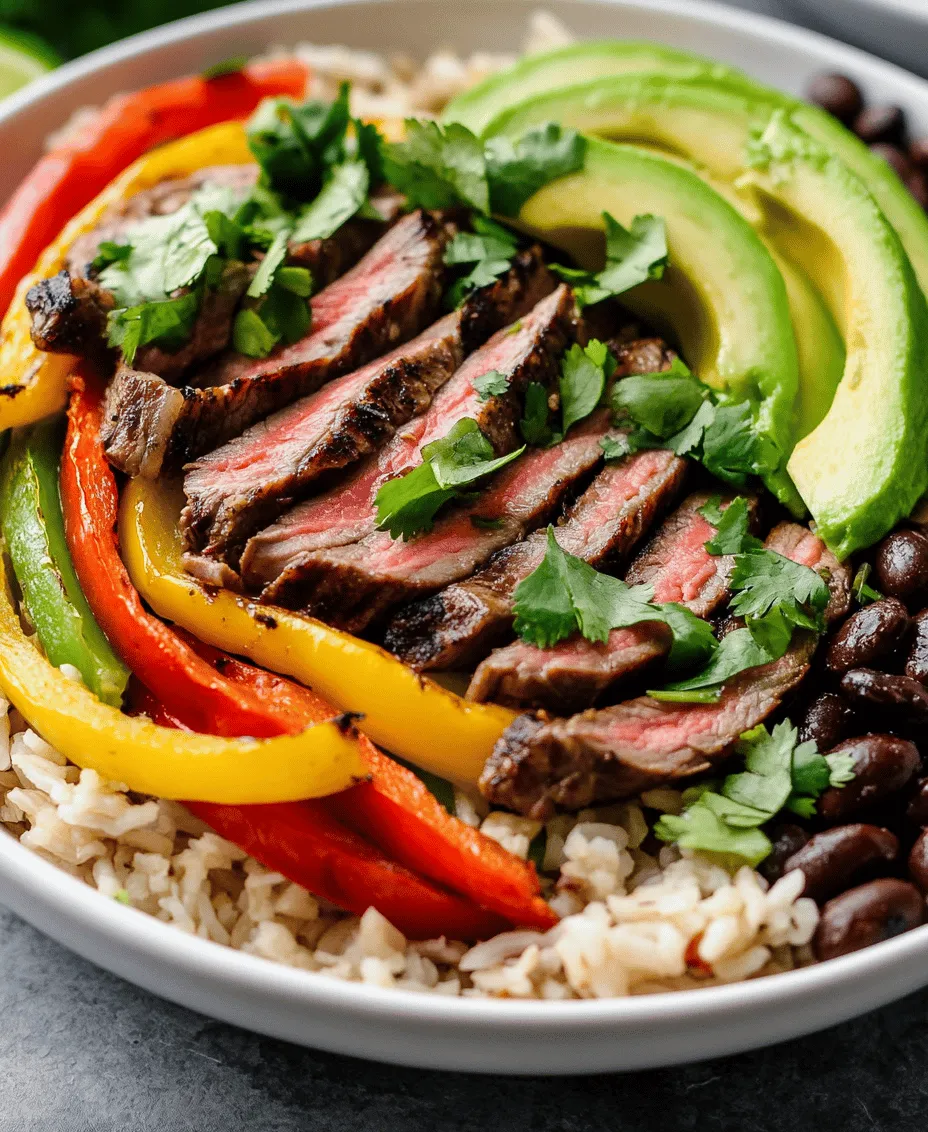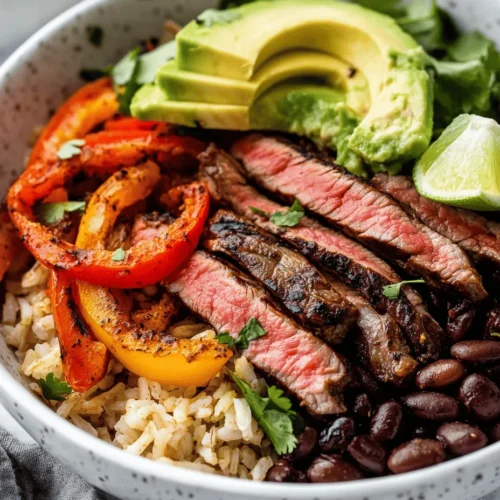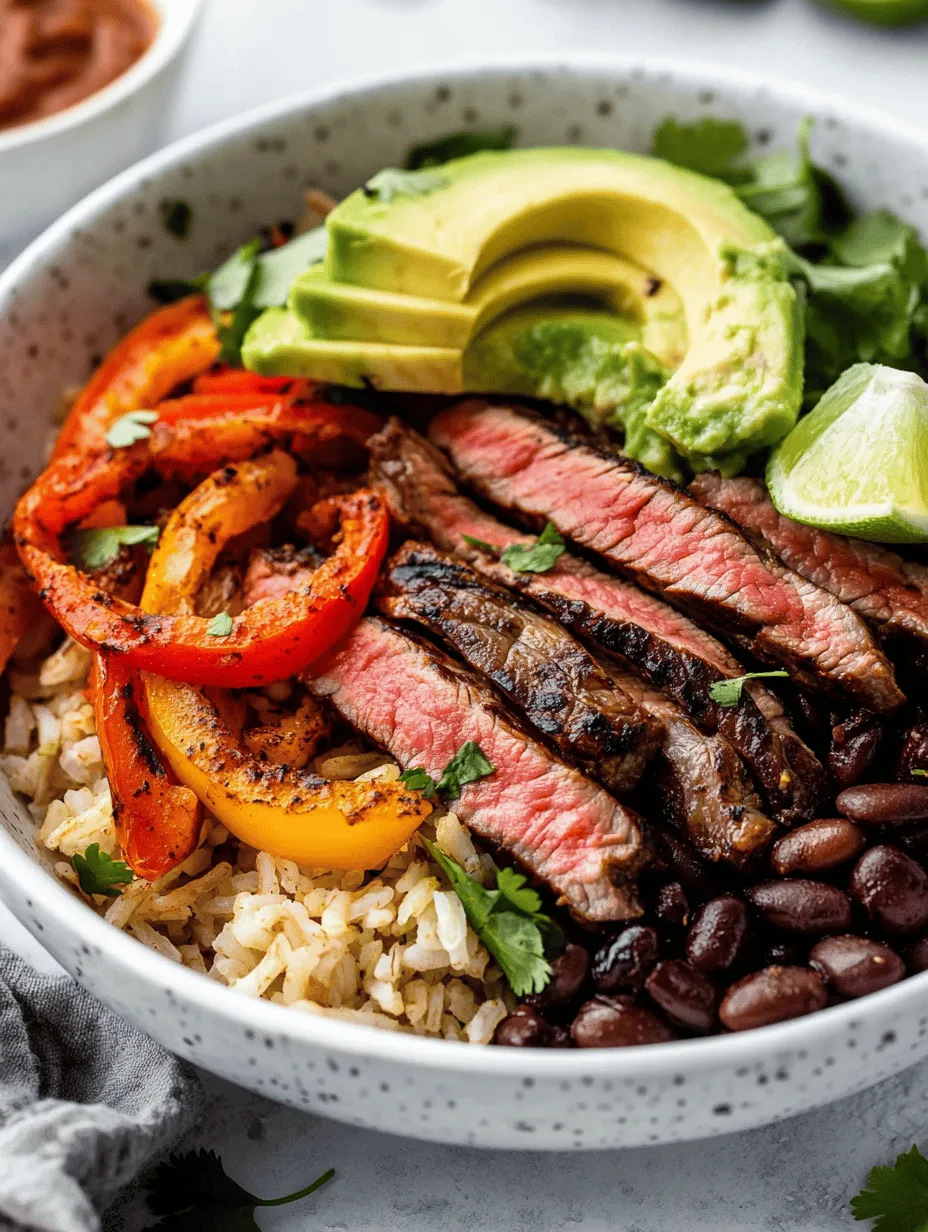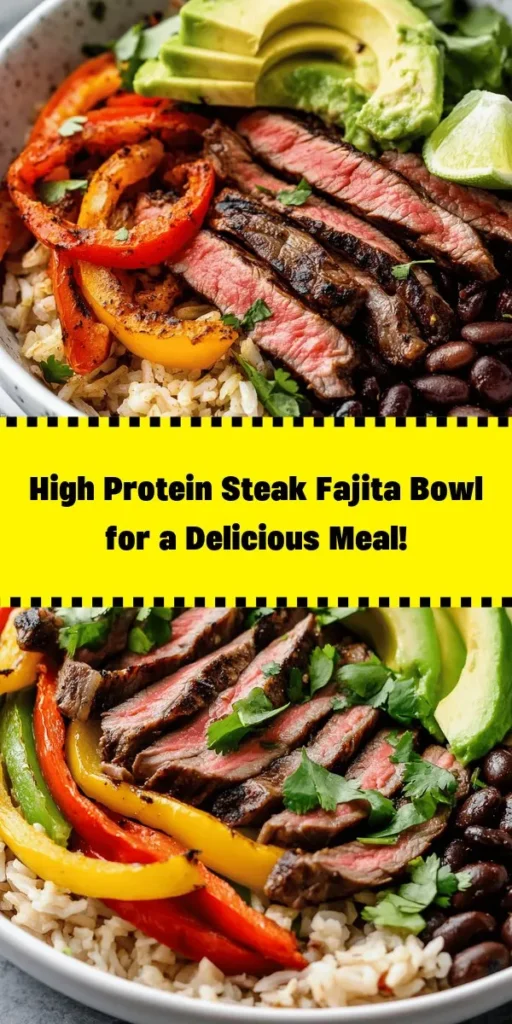Introduction
In today’s fast-paced world, where health and convenience often go hand in hand, the high protein steak fajita bowl emerges as a perfect solution for those seeking both nutrition and flavor. This dish combines the robust flavors of marinated steak with a colorful medley of vegetables, all served over a bed of wholesome grains. Not only is this dish a feast for the eyes, but it also boasts a wealth of health benefits, making it an appealing option for a wide range of dietary preferences—from fitness enthusiasts aiming to boost their protein intake to food lovers in search of vibrant and delicious meals.
The trend of protein-packed meals has seen a significant rise in popularity, particularly among those looking to maintain or build muscle, lose weight, or simply enjoy a healthier diet. The high protein steak fajita bowl stands out in this culinary landscape due to its versatility and the ease with which it can be customized. Whether you’re a seasoned cook or a kitchen novice, this dish allows for creativity, ensuring that you can cater to your taste preferences while keeping your nutritional goals in check.
In this article, we will explore the nutritional benefits of each ingredient in the steak fajita bowl, discuss the best cuts of steak, delve into the importance of marinating for flavor, and provide cooking techniques that guarantee perfectly cooked steak. Let’s dive into the world of flavors and health benefits that the high protein steak fajita bowl has to offer.
Understanding the Nutritional Benefits of the Ingredients
The high protein steak fajita bowl is not only a tasty meal but also a nutritional powerhouse, thanks to the carefully selected ingredients. Let’s break down the health advantages of each component that makes this bowl a guilt-free indulgence.
Flank Steak or Sirloin Steak
The star of the high protein steak fajita bowl is undoubtedly the steak, and both flank and sirloin cuts are excellent choices. Flank steak is a lean cut known for its robust flavor and tenderness when cooked properly. It contains approximately 26 grams of protein per 3-ounce serving, making it a fantastic source of high-quality protein that supports muscle repair and growth.
Sirloin steak, on the other hand, is slightly more marbled, offering a bit more fat which contributes to its rich flavor. It also provides around 25 grams of protein per serving, along with essential amino acids that are crucial for overall health. Additionally, both cuts are rich in iron, a vital mineral that plays a key role in oxygen transport and energy production in the body.
Olive Oil
Adding olive oil to the steak fajita bowl not only enhances the flavor but also provides an array of health benefits. Rich in monounsaturated fats, particularly oleic acid, olive oil is known for its heart-healthy properties. It is also packed with antioxidants, such as vitamin E and polyphenols, which help combat inflammation and protect against chronic diseases. Including olive oil in your cooking not only adds a delicious depth to the marinade but also contributes to the overall nutrient profile of the dish.
Bell Peppers and Onions
The colorful bell peppers and onions in the fajita bowl are not just eye-catching; they also deliver a wealth of vitamins and minerals. Bell peppers, especially red and yellow varieties, are high in vitamin C, which is essential for immune function and skin health. They also contain vitamin A and various antioxidants that contribute to overall health.
Onions, while often overlooked, are also packed with nutrients. They are a good source of vitamin B6, manganese, and various antioxidants, including quercetin, which has anti-inflammatory properties. Together, these vegetables not only add a crunch and sweetness to the bowl but also ensure that you’re getting a balanced dose of essential nutrients.
Brown Rice or Quinoa
When it comes to the base of the fajita bowl, both brown rice and quinoa are excellent choices that provide complex carbohydrates and fiber. Brown rice is a whole grain that retains its bran and germ, offering more nutrients and fiber than white rice. It is a good energy source and helps maintain stable blood sugar levels.
Quinoa, on the other hand, is a pseudo-grain that is gluten-free and considered a complete protein, meaning it contains all nine essential amino acids. This makes it an ideal choice for those following a vegetarian or vegan diet. Both options provide a hearty base for the fajita bowl, ensuring you feel satisfied and energized.
Black Beans
Black beans are a fantastic addition to the high protein steak fajita bowl, enhancing both flavor and nutrition. They are an excellent plant-based protein source, providing about 15 grams of protein per cup along with 15 grams of dietary fiber. This combination helps promote digestive health and keeps you feeling full longer. Additionally, black beans are rich in folate, magnesium, and various antioxidants, making them a nutrient-dense option for any meal.
Avocado
Avocado is often hailed as a superfood, and for good reason. This creamy fruit is loaded with healthy monounsaturated fats, particularly oleic acid, which supports heart health. Avocado also contains a variety of vitamins, including vitamin K, vitamin E, and several B vitamins. Its high fiber content aids in digestion and helps maintain a feeling of fullness. Adding avocado to the fajita bowl not only enhances the flavor and texture but also boosts the nutritional value significantly.
Lime Juice and Cilantro
Finally, lime juice and cilantro are the finishing touches that elevate the fajita bowl. Lime juice adds a zesty brightness that balances the richness of the steak and avocado. It is also rich in vitamin C and provides a refreshing flavor profile. Cilantro, with its unique taste, is packed with antioxidants and has been associated with various health benefits, including anti-inflammatory properties. Together, these ingredients not only enhance the flavor of the dish but also contribute to its overall nutritional benefits.
Choosing the Right Cut of Steak
Selecting the right cut of steak is crucial for achieving the best flavor and texture in your high protein steak fajita bowl. The two most popular options—flank steak and sirloin steak—each have their own merits.
Flank Steak vs. Sirloin Steak
Flank steak is known for its rich flavor and fibrous texture, making it ideal for marinating. It’s best cooked quickly over high heat to avoid toughness, and when sliced against the grain, it becomes tender and juicy. This cut is particularly popular in fajitas due to its ability to absorb marinades well.
Sirloin steak, on the other hand, is a bit more tender and marbled, which can lead to a juicier bite. It is slightly more forgiving in terms of cooking time, making it a versatile option for various cooking methods. The choice between flank and sirloin often comes down to personal preference in flavor and texture.
Tips for Selecting Quality Meat
When shopping for steak, it’s important to look for quality cuts that will enhance your dish. Here are some tips for selecting the best meat at the butcher or grocery store:
1. Look for Marbling: Marbling refers to the small flecks of fat interspersed within the muscle. A good amount of marbling indicates flavor and tenderness.
2. Check the Color: Fresh beef should have a bright red color. Avoid cuts that look dull or brown, as they may be older.
3. Feel for Firmness: The steak should feel firm to the touch. A soft or mushy texture may indicate spoilage.
4. Ask Your Butcher: If you’re uncertain, don’t hesitate to ask your butcher for recommendations based on your cooking plans. They can provide insights into the best cuts for your fajita bowl.
Marinade Magic: Enhancing Flavor
Marinating the steak is a crucial step that enhances both flavor and tenderness. A good marinade will penetrate the meat, infusing it with bold flavors while also helping to break down tough fibers.
Breakdown of the Marinade Ingredients
For the high protein steak fajita bowl, a simple yet flavorful marinade can be made using:
– Olive Oil: Acts as a base and helps to keep the meat moist.
– Chili Powder: Adds a spicy kick and depth of flavor.
– Cumin: Provides a warm, earthy taste that complements the other spices.
– Smoked Paprika: Infuses the meat with a rich, smoky flavor.
– Garlic: Offers aromatic qualities and enhances overall taste.
– Salt and Pepper: Essential for seasoning and enhancing the natural flavors of the steak.
Marinating Time
For the best results, marinate the steak for a minimum of 30 minutes. This allows the flavors to penetrate the meat, resulting in a more flavorful dish. However, if you have the time, marinating the steak overnight is ideal. This extended time allows the acid in the marinade to work its magic, tenderizing the meat further and enhancing its flavor profile.
In the next part of our article, we will explore the cooking techniques for achieving the perfect steak, ensuring that your high protein steak fajita bowl is nothing short of spectacular. Stay tuned to learn how to cook your steak to perfection, guaranteeing a meal that is both delicious and nutritious.

Grilling vs. Skillet Cooking: Pros and Cons of Each Method
When it comes to cooking steak fajitas, the method you choose can significantly impact the flavor and texture of your dish. Both grilling and skillet cooking have their advantages and disadvantages.
Grilling is a fantastic way to achieve a smoky flavor and beautiful char marks on your steak. The direct heat from the grill sears the surface of the meat, locking in juices and creating a delicious crust. However, grilling requires more preparation, including heating up the grill and managing flare-ups. Additionally, it can be challenging to control the heat, especially if you’re cooking multiple steaks at once.
Skillet cooking, on the other hand, offers more control over the cooking temperature and allows you to sauté vegetables simultaneously. Using a cast-iron skillet can yield a nice sear while enabling you to easily manage the cooking process. The downside is that you might miss out on that signature grilled flavor, and there might not be the same charred effect on the meat.
Ultimately, the choice between grilling and skillet cooking depends on your preference and available equipment. If you’re looking for that authentic fajita taste, grilling is the way to go. If you prefer convenience and control, skillet cooking is an excellent option.
The Importance of Letting the Steak Rest After Cooking
Regardless of the cooking method you choose, one crucial step that should never be overlooked is allowing your steak to rest after cooking. Resting is vital because it gives the meat time to redistribute its juices, resulting in a juicier and more flavorful steak. When steak is cooked, the muscle fibers contract and push the juices toward the center of the meat. By resting it for about 5-10 minutes after cooking, you allow the fibers to relax, and the juices to redistribute evenly throughout the steak, ensuring that each bite is moist and tender.
To rest your steak, simply transfer it to a cutting board and cover it loosely with aluminum foil. This will keep it warm while it rests, preparing it for slicing and serving.
Sautéing Vegetables for Maximum Flavor
Sautéing vegetables is an integral part of creating a delicious steak fajita bowl. Achieving the right texture and flavor can elevate your dish significantly. Here’s a step-by-step guide on how to sauté vegetables effectively:
1. Choose the Right Vegetables: For fajitas, bell peppers and onions are classic choices. You can experiment with other vegetables like zucchini, mushrooms, or corn to add variety.
2. Prep Your Vegetables: Slice bell peppers and onions into thin strips. Uniform sizes are essential for even cooking.
3. Heat Your Pan: Preheat your skillet over medium-high heat. Use a heavy-bottomed pan, such as cast iron, for even heat distribution.
4. Add Oil: Once the skillet is hot, add a tablespoon of oil (olive oil or avocado oil works well). Swirl it around to coat the pan evenly.
5. Add Vegetables: Carefully add your sliced vegetables to the pan. Avoid overcrowding the pan, as this can lead to steaming instead of sautéing.
6. Sauté: Stir the vegetables frequently, allowing them to caramelize and develop a rich flavor. Aim for about 5-7 minutes until they are tender but still crisp, with a slight char.
7. Season: Season your vegetables with salt, pepper, and any other spices you prefer (such as chili powder or cumin) while they cook. This enhances their flavor and ensures that the seasoning penetrates the vegetables.
Tips for Achieving the Perfect Char on Bell Peppers and Onions
To achieve the perfect char on your bell peppers and onions, consider the following tips:
– High Heat: Ensure your skillet is hot before adding the vegetables. High heat is essential for that quick sear and char.
– Do Not Stir Too Often: Allow the vegetables to sit undisturbed for a minute or two to develop a char before stirring. This creates a nice caramelized surface.
– Use Fresh Vegetables: Fresh, firm vegetables will yield the best results. Avoid using limp or old vegetables, as they will not cook properly.
– Experiment with Seasoning: Adding spices like smoked paprika or garlic powder can enhance the flavor and contribute to a lovely char.
Building Your Fajita Bowl: Layering for Flavor and Nutrition
As you prepare to assemble your steak fajita bowl, it’s important to consider how to layer your ingredients for optimal flavor and nutrition. Here’s a step-by-step process to guide you:
1. Choose Your Base Layer: Start with a nutritious base. Brown rice and quinoa are both excellent choices. Brown rice provides fiber and a nutty flavor, while quinoa is a complete protein, offering all nine essential amino acids. Choose one based on your nutritional preferences or use a mix of both for added texture.
2. Add Your Steak: Slice your rested steak against the grain into thin strips. This ensures tenderness and makes it easier to eat. Evenly distribute the steak over the base layer.
3. Incorporate Sautéed Vegetables: Add a generous portion of your sautéed bell peppers and onions on top of the steak. Ensure an even distribution so that every bite has a balance of vegetables and meat.
4. Toppings: This is where you can get creative! Add toppings like diced tomatoes, corn, black beans, or shredded lettuce for added texture and nutrition.
5. Layering for Balance: To achieve a balanced bowl, aim for a mixture of protein, healthy fats, and carbohydrates. This will keep you full and satisfied.
6. Plating and Presentation: For an appealing presentation, consider using a large, shallow bowl. Arrange the ingredients in sections, allowing each component to shine. A sprinkle of fresh herbs, like cilantro, on top can add a burst of color and flavor.
Adding Fresh Ingredients for a Zesty Finish
To elevate your steak fajita bowl, don’t forget about the finishing touches that can enhance flavor and nutrition:
– Avocado: Adding sliced avocado provides creaminess and healthy fats, making your bowl more satisfying. Avocado is rich in monounsaturated fats, which are great for heart health.
– Lime Juice: A squeeze of fresh lime juice over the top brightens the flavors and adds a zesty kick. The acidity helps to balance the richness of the steak and avocado.
– Fresh Cilantro: Garnishing with fresh cilantro adds both flavor and visual appeal. Not only does it complement the fajitas, but it also provides a fresh, herbaceous note that ties the dish together.
Serving Suggestions and Variations
When it comes to serving your steak fajita bowl, there are countless ways to customize it based on your preferences and dietary needs:
– Optional Toppings: Consider adding Greek yogurt or sour cream for creaminess. Both options can add a tangy flavor that complements the dish well.
– Dietary Variations: For a vegetarian option, swap the steak for grilled portobello mushrooms or marinated tofu. For a gluten-free version, ensure your base and toppings are certified gluten-free.
– Seasonal Variations: Take advantage of seasonal produce. In the summer, consider adding grilled corn or zucchini, while in the fall, roasted butternut squash can add a delightful sweetness.
Conclusion
The high-protein steak fajita bowl is not only a delicious and satisfying meal but also a versatile dish that caters to various dietary lifestyles. By selecting fresh ingredients, using effective cooking techniques, and layering flavors thoughtfully, you can create a bowl that is both nutritious and packed with flavor.
Whether you’re preparing this dish for a family dinner or meal prep for the week, the steak fajita bowl is sure to impress. Enjoy the process of making it at home, and don’t hesitate to customize it to suit your taste. With its vibrant colors and hearty ingredients, this dish is perfect for any occasion, ensuring that each bite is a delightful experience.



